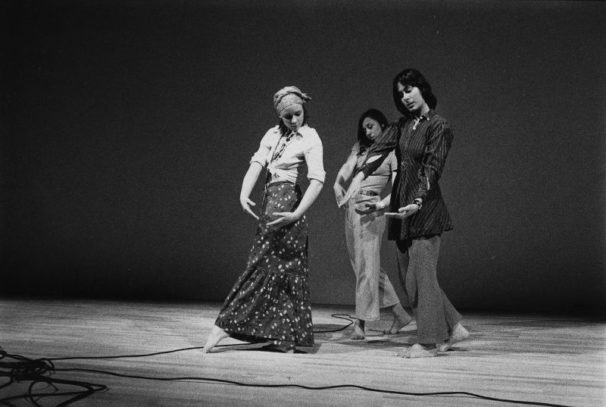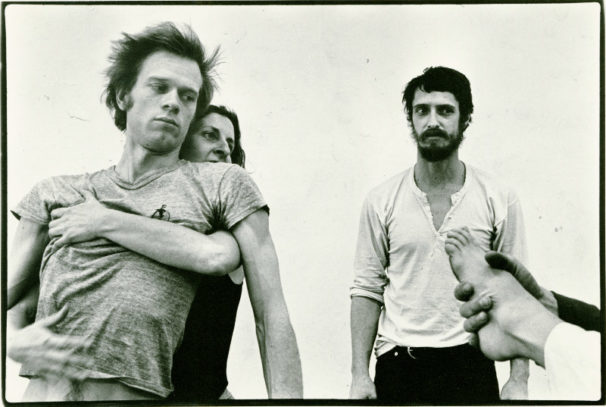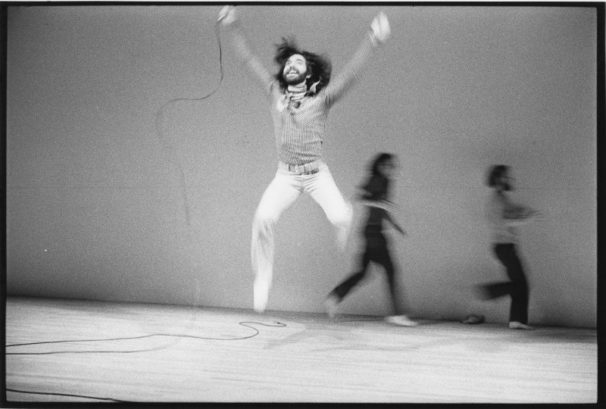
Ed. note: Guest author Elizabeth Zimmer contributes this review of Wendy Perron‘s new book, The Grand Union: Accidental Anarchists of Downtown Dance, 1970-1976.
If you miss dance in our time of pandemic-related deprivation, get this book. Wendy Perron, a near-contemporary and sometime colleague of members of the Grand Union, was uniquely qualified to write it: a trained dancer, she has also been, over a career now spanning more than 50 years, a choreographer, company director, curator, teacher, scholar, critic, and editor in chief of Dance Magazine. A member of Trisha Brown’s early, all-woman company, she watched Grand Union in performance, and has grappled with the complex issues facing touring troupes. She brings to life the people, places, and historical moment behind her subjects’ remarkable accomplishment. She’s been an assiduous researcher, and certainly not least she was, and remains, a fan.

I am personally grateful to Perron (whom I’ve known since we were students at Bennington College in the mid- ‘60s) because I lived outside the United States for Grand Union’s entire lifespan, and never saw them perform. Initiated by Yvonne Rainer, the ensemble evolved from a legendary composition class taught by Robert Dunn, which generated the Judson Dance Theater; that enterprise and Rainer’s later Continuous Project—Altered Daily served as training grounds for half a dozen artists who went on to change the course of American dance, among them David Gordon, Steve Paxton, Barbara Dilley, Nancy Lewis, Douglas Dunn, and the late Trisha Brown. Each possessed unique capacities, and all went on to forge significant careers.
An early member of the group, Lincoln Scott, was its youngest and only African American participant; he drifted away and returned to the west coast. Perron includes an interview with Dianne McIntyre, another black dancer who forged a parallel career as a choreographer and improviser, working with jazz musicians in her group Sounds in Motion. Becky Arnold also began with Grand Union, but since she had “no aspirations to do her own work” or to improvise, according to Rainer, she left the group, and New York City, in 1972.

Active in the earliest days of the video revolution, the dancers left relatively few documents of their work; Perron spent years uncovering recordings, photographs, and other materials to assemble this multi-faceted group portrait. Rainer, the original prime mover, left after a while to pursue a career as a feminist filmmaker. Paxton engineered the early experiments that evolved into Contact Improvisation while on tour with Grand Union at Oberlin College. Brown indulged her penchant for climbing and her sharp choreographic eye. Gordon played dress-up and talked and joked; steeped in movies and television, he had a tendency to “frame” things and has produced a wonderful “Archiveography” viewable at davidgordon.nyc. Dilley laid the foundation for her Contemplative Dance Practice, which later found a home at Naropa Institute in Colorado. Dunn, the youngest member after Scott departed, continues making appealing, idiosyncratic work all these decades later. Perron’s book has a scrapbook-like structure, and reads like it wants to have dozens of hyperlinks, connecting observations by other artists and critics to her own narrative descriptions of the extant videotapes themselves, and her reports of Grand Union’s impact on the field.

Anyone struggling to teach young dance artists in this difficult time should share this volume with them; it’s not merely a history, but also a collection of ways of knowing, full of resources that bring to life a period of great change in the life of New York City and the country as a whole. Emboldened by the “sexual revolution,” philosophies traceable to John Cage, and what they perceived as their success in shutting down the war in Vietnam, experimenters in the downtown arts community colonized cheap living spaces and offered their work at very low ticket prices; audiences sat on the floor and sometimes infiltrated the stage. Grand Union embodied the spirit of its ‘70s moment, and this book will help its legacy endure.
photo information
GU at Walker Art Center, lec-dem, 1971. From left: Dilley, Becky Arnold, Rainer. photo: Tom Berthiaume, courtesy Walker Art Center.
GU in Trisha Brown’s loft, in “rehearsal,” June 1975. From left: Dunn, Brown, Paxton, Gordon’s hand, Lewis’s foot. photo: Robert Alexander Papers, Special Collections, New York University
From left: Scott, Rainer, Screen grabs from video by Steve Christiansen
David Gordon, Walker Art Center, lec-dem, 1971. photo: Tom Berthiaume, courtesy Walker Art Center
Elizabeth Zimmer writes about the arts for print and digital outlets worldwide.
The Grand Union: Accidental Anarchists of Downtown Dance, 1970-1976, by Wendy Perron. 2020, Wesleyan University Press, 384 pp. 65 photographs, $27.95
“The Alchemy of Grand Union” virtual book talk | Wendy Perron and Douglas Dunn | free on Zoom, register HERE.
